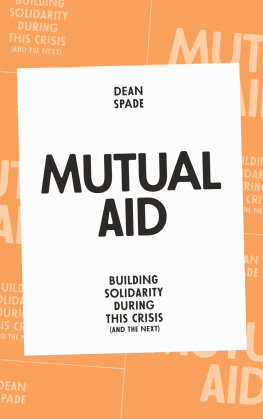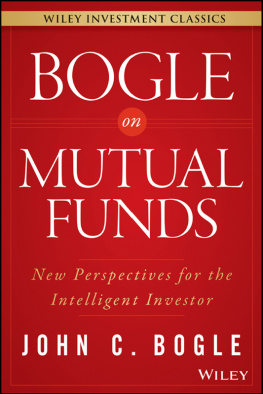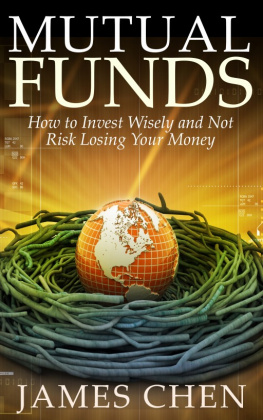Dean Spade - Mutual Aid
Here you can read online Dean Spade - Mutual Aid full text of the book (entire story) in english for free. Download pdf and epub, get meaning, cover and reviews about this ebook. publisher: Verso Books, genre: Politics. Description of the work, (preface) as well as reviews are available. Best literature library LitArk.com created for fans of good reading and offers a wide selection of genres:
Romance novel
Science fiction
Adventure
Detective
Science
History
Home and family
Prose
Art
Politics
Computer
Non-fiction
Religion
Business
Children
Humor
Choose a favorite category and find really read worthwhile books. Enjoy immersion in the world of imagination, feel the emotions of the characters or learn something new for yourself, make an fascinating discovery.
- Book:Mutual Aid
- Author:
- Publisher:Verso Books
- Genre:
- Rating:4 / 5
- Favourites:Add to favourites
- Your mark:
- 80
- 1
- 2
- 3
- 4
- 5
Mutual Aid: summary, description and annotation
We offer to read an annotation, description, summary or preface (depends on what the author of the book "Mutual Aid" wrote himself). If you haven't found the necessary information about the book — write in the comments, we will try to find it.
Mutual Aid — read online for free the complete book (whole text) full work
Below is the text of the book, divided by pages. System saving the place of the last page read, allows you to conveniently read the book "Mutual Aid" online for free, without having to search again every time where you left off. Put a bookmark, and you can go to the page where you finished reading at any time.
Font size:
Interval:
Bookmark:

Mutual Aid
Mutual Aid
Building Solidarity During
This Crisis (and the Next)
Dean Spade

First published by Verso 2020
Dean Spade 2020
All rights reserved
The moral rights of the author have been asserted
A teaching guide to accompany this book is available online at
http://v.versobooks.com/Mutual_Aid_Teaching_Guide.pdf
1 3 5 7 9 10 8 6 4 2
Verso
UK: 6 Meard Street, London W1F 0EG
US: 20 Jay Street, Suite 1010, Brooklyn, NY 11201
versobooks.com
Verso is the imprint of New Left Books
ISBN-13: 978-1-83976-212-3
ISBN-13: 978-1-83976-213-0 (UK EBK)
ISBN-13: 978-1-83976-214-7 (US EBK)
British Library Cataloguing in Publication Data
A catalogue record for this book is
available from the British Library
Library of Congress Cataloging-in-Publication Data
A catalog record for this book is available
from the Library of Congress
Typeset in Sabon MT by Hewer Text UK Ltd, Edinburgh
Printed and bound by CPI Group (UK) Ltd, Croydon CR0 4YY
Contents
Crisis Conditions
Require Bold Tactics
The contemporary political moment is defined by emergency. Acute crises, like the COVID-19 pandemic and climate changeinduced fires, floods, and storms, as well as the ongoing crises of racist criminalization, brutal immigration enforcement, endemic gender violence, and severe wealth inequality, threaten the survival of people around the globe. Government policies actively produce and exacerbate the harm, inadequately respond to crises, and ensure that certain populations bear the brunt of pollution, poverty, disease, and violence. In the face of this, more and more ordinary people are feeling called to respond in their communities, creating bold and innovative ways to share resources and support vulnerable neighbors. This survival work, when done in conjunction with social movements demanding transformative change, is called mutual aid.
Mutual aid has been a part of all large, powerful social movements, and it has a particularly important role to play right now, as we face unprecedented dangers and opportunities for mobilization. Mutual aid gives people a way to plug into movements based on their immediate concerns, and it produces social spaces where people grow new solidarities. At its best, mutual aid actually produces new ways of living where people get to create systems of care and generosity that address harm and foster well-being.
This book is about mutual aid: it explains why it is so important, what it looks like, and how to do it. It provides a grassroots theory of mutual aid as well as concrete tools for addressing some of the most difficult questions facing mutual aid groups, such as how to work in groups and make decisions together, how to prevent and address conflict, and how to deal with burnout so that we can build a lasting mobilization that can win.
Left social movements have two big jobs right now. First, we need to organize to help people survive the devastating conditions unfolding every day. Second, we need to mobilize hundreds of millions of people for resistance so we can tackle the underlying causes of these crises. In this pivotal moment, movements can strengthen, mobilizing new people to fight back against cops, immigration enforcement, welfare authorities, landlords, budget cuts, polluters, the defense industry, prison profiteers, and right-wing groups. The way to tackle these two big tasksmeeting peoples needs and mobilizing them for resistanceis to create mutual aid projects and get lots of people to participate in them. Social movements that have built power and won major change have all included mutual aid, yet it is often a part of movement work that is less visible and less valued. In this moment, our ability to build mutual aid will determine whether we win the world we long for or dive further into crisis.
We can imagine what is possible when we come together in this way by examining the response of Hong Kongs protest movement to COVID-19. In 2019, a massive anti-government mobilization swept Hong Kong, with people opposing police and seeking greater control over their lives. By the time the COVID-19 pandemic emerged, Hong Kongs chief executive, Carrie Lam, had an 80 percent disapproval rating. Hong Kongs protest movement had escalated significantly, with protesters coordinating sophisticated mass mobilizations, including the use of bold tactics like fighting police with poles, projectiles, laser pointers, and petrol bombs. Lam was remarkably non-responsive to the pandemic, despite the vulnerable position of Hong Kong, a densely packed city with a history of epidemics and a high-speed railway connection to Wuhan, where the COVID-19 pandemic started. Hong Kong residents criticized Lam for her delay in closing the citys borders and her order barring city workers from wearing masks. But, despite the governments failures, the people of Hong Kong, mobilized by the protest movement, launched a response that suppressed the original wave of COVID-19 and mitigated its resurgence.
On the day the first COVID-19 case in Hong Kong was confirmed, people from the protest movement created a website that tracked cases, monitored hot spots, reported hospital wait times, and warned about places selling fake personal protective equipment (PPE). The protesters defied the governments ban on masks and countered misinformation from the World Health Organization discouraging their use. They set up brigades that made and distributed masks, specially making sure they reached poor people and old people. They created a system of volunteers to set up hand sanitizer stations throughout crowded tenement housing and maintain the supply of sanitizer at the stations. They also created digital maps to identify the station sites.
This essential mutual aid work was complemented by bolder strategies. When the government refused to close the border with China, seven thousand medical workers, as part of labor unions that had been formed during the protest movement, went on strike demanding PPE and that the border be closed. Members of the protest movement threatened the government with stronger action if steps were not taken to address the epidemic, and explosives were found at the border with China, possibly for this purpose. The Hong Kong government then created quarantine centers in dense neighborhoods, but never consulted the people in those neighborhoods, and the protest movement responded by throwing explosives into the quarantine centers before they were used, causing the government to change the location of the facilities to less densely populated holiday villages.
As a result of these efforts by a mobilized and coordinated movement, and no thanks to the government, Hong Kong had an immensely successful response to the first wave of COVID-19. Through the combination of mutual aid and direct action to force concessions, the protesters did what the government would not do on its own, saving untold numbers of lives.
This book provides a concrete guide for building mutual aid groups and networks. dives into the nitty-gritty of how to work together in mutual aid groups and how to handle the challenges of group decision-making, conflict, and burnout. It includes charts and lists that can be brought to group meetings to stimulate conversation and build shared analysis and group practices. Ultimately, helps imagine how we can coordinate to collectively take care of ourselveseven in the face of disasterand mobilize hundreds of millions of people to make deep and lasting change.
Font size:
Interval:
Bookmark:
Similar books «Mutual Aid»
Look at similar books to Mutual Aid. We have selected literature similar in name and meaning in the hope of providing readers with more options to find new, interesting, not yet read works.
Discussion, reviews of the book Mutual Aid and just readers' own opinions. Leave your comments, write what you think about the work, its meaning or the main characters. Specify what exactly you liked and what you didn't like, and why you think so.










